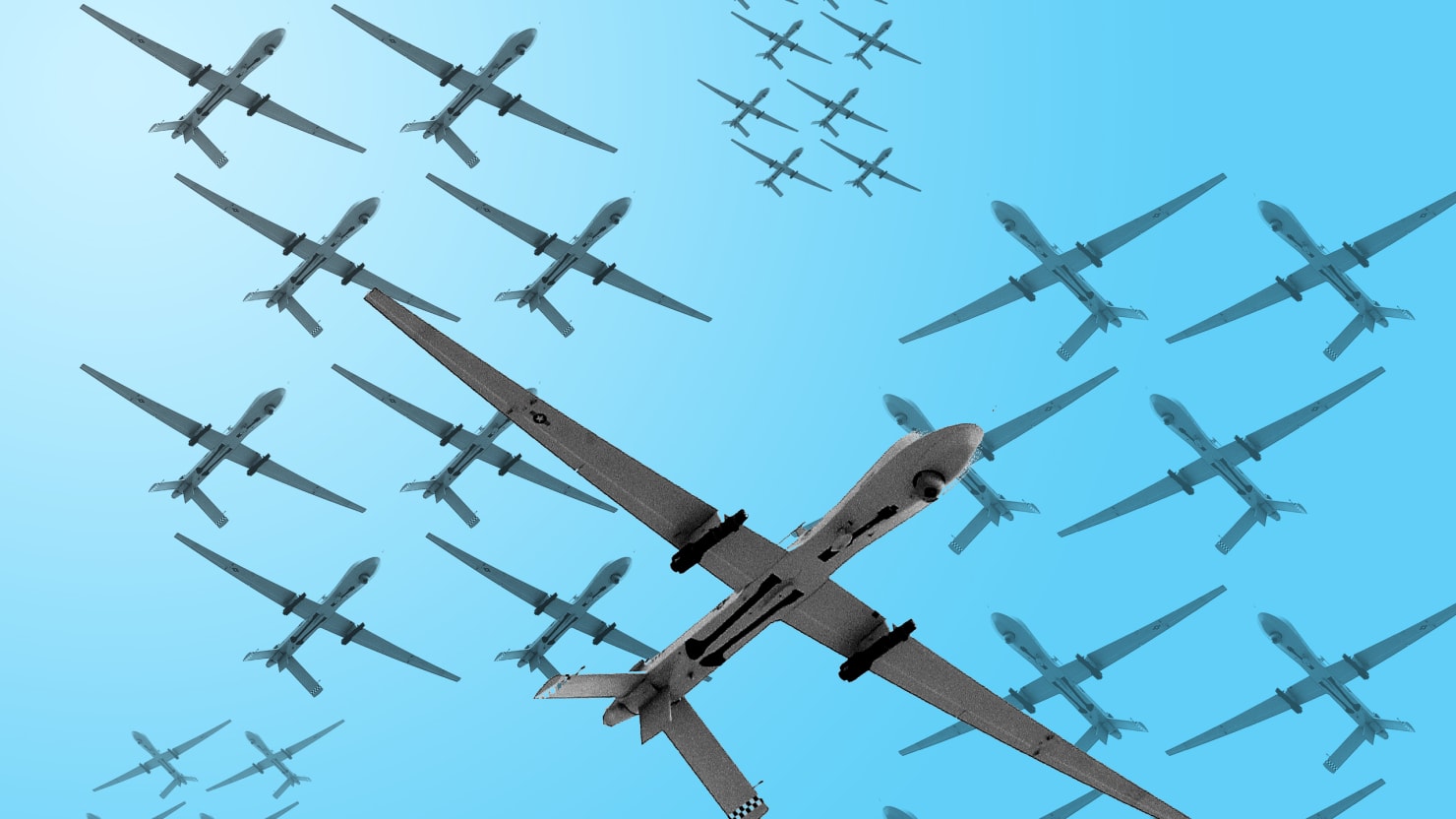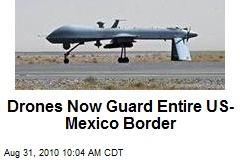
Citing threats from drug cartels to migrants, US responds with a $487 million federal plan to counter small drones
Ken Klippenstein and Alex Emmons / The Intercept
(May 5, 2021) — In April, US Army officers met with representatives from Aurora Flight Sciences, a Virginia-based subsidiary of Boeing, to test whether the company’s technology could intercept and bring down an enemy drone. Aurora was one of three companies that took part in the test at the army’s Yuma Proving Ground, just 50 miles from the US-Mexico border in Arizona.
A marketing video shows how the system works: The AI-guided drone uses ground-based radar to locate other drones (called UAVs or UAS, short for unmanned aerial vehicles or unmanned aircraft systems) from range. When it gets close to an “enemy” drone, it “locks on with an onboard sensor” and fires a small projectile. The object fouls up the helicopter blades, and the “enemy” drone falls to the ground.
The demonstration was the first of its kind, held by the Defense Department’s Joint Counter-Small Unmanned Aircraft Systems Office — the Joint C-sUAS Office, also called JCO — and a second one is planned for September. According to US Army Col. Greg Soulé, director of the acquisition and resources division at JCO, who briefed reporters in April, the test came after 35 separate companies submitted white papers in response to a January request for information.
The demonstration was specifically focused on ways to defeat small drones in such a way as to “minimize collateral damage,” said Leland Browning, deputy director of JCO. “For example, if you were operating in urban terrain, and you wanted to minimize the amount of collateral damage from taking out one of these enemy UAS,” Browning continued, acknowledging the risk drones can pose to bystanders and infrastructure.
The tests are part of a rapid effort by the US government to develop an answer to small drones, which are increasingly being used by terror groups and drug cartels. The staggering demand — hundreds of millions of dollars’ worth of funding for research, in contrast to the relatively cheap cost of small consumer drones — has already created a private economy to produce counter-drone technology for the military, involving dozens of aerospace and defense companies.
In the current fiscal year, the Defense Department is looking to spend at least $404 million on research and development and at least $83 million on procurement of counter-UAS technology, according to a report by the Congressional Research Service. And other agencies, including Customs and Border Protection, are looking to capture a share of the market, raising concerns that the efforts could lead to further surveillance and militarization of the US-Mexico border.
A review of contracting documents, as well as internal CBP documents and interviews with officials, shows that criminals using small drones, often to evade law enforcement, are now a major concern for CBP, which is casting a wide net looking for solutions to the problem.
In February, CBP put out a request for information to private companies, seeking ways to respond to drones, including by radio frequency jamming and “kinetic attack” — a broad term that could encompass everything from surface-to-air projectiles to the small drones being researched by the Army. As the request states, “CBP is interested in learning about the availability of systems to counter the threat of unmanned aircraft systems (UAS), commonly referred to as drones, which includes the capability to detect, identify, classify, track, and/or mitigate these threats.”
Requests for information are used to gather information about a certain product or service and often precede acquisition of that product or service. CBP, which currently uses drones for surveillance purposes, says it’s researching these capabilities in order to respond to drones used by criminal organizations “for smuggling activities and for monitoring CBP operations.”

“The RFI is merely that,” Jason Givens, a CBP press officer, told The Intercept, “a request for information on the current availability and technological capabilities of a Counter Unmanned Aircraft System (C-UAS) to address current and future threats and gaps regarding unmanned aircraft systems. It does not mean that CBP is interested in obtaining ‘kinetic attack’ capabilities.”
There is some basis for CBP’s drone concerns. Mexico’s defense secretary last month said that drug cartels have used drones carrying explosives to attack law enforcement and military personnel. This echoes the Islamic State’s widely reported use of small drones to drop grenades on targets. While there’s no evidence of anything that dire happening in the US, people have pleaded guilty to retrieving drugs delivered by drone. Southwest border residents have reportedly seen a rise in drone activity recently.
It’s likely that CBP’s efforts to counter drones will become a part of the trend toward militarizing the US-Mexico border. That trend had seemed to reach its peak under the Trump administration, which deployed thousands of US troops there during his presidency and declared a national emergency to unilaterally fund the construction of a $15 billion border wall without Congress’s approval. While President Joe Biden revoked the emergency declaration, many of the troops remain.
Yet these attempts to crack down on the border have given rise to more sophisticated methods of circumvention, of which drones are a prominent example, a CBP intelligence agent not authorized to speak publicly told The Intercept. Drones have become a major concern for CBP as they are increasingly used for reconnaissance purposes by cartels and also by guides who assist undocumented migrants crossing the border, he explained. Yet he was skeptical of the idea that drones with kinetic attack abilities were a practical solution, instead saying they represent the kind of government waste endemic to the military. “The counter [drone] stuff seems like Soldier of Fortune fluff,” the CBP official said. “Like, ‘Hey this would be cool, taser rounds you fire from a shotgun!’”
Even so, CBP is examining its air capabilities, having looked at equipping its air assets with sophisticated sensor systems as well as laser designators to “highlight TOIs,” or targets of interest, according to an excerpt from an internal CBP study from May 2019 obtained by The Intercept. CBP has a history of using lasers to pinpoint migrants for physical pursuit. Asked about the lasers, Givens, the CBP spokesperson, said: “CBP has not, and currently is not evaluating deploying laser designators as a counter-UAS device.”
The study, a document exploring modifications to the technical specifications of CBP’s air assets, doesn’t specify any targets but does catalog threats it says CBP faces at the border, including terrorists, drug smugglers, and “undocumented aliens.” A source familiar with the study expressed grave concerns that undocumented migrants were being lumped in with legitimate threats like drug traffickers. “CBP confronts a variety of threats at America’s maritime borders including terrorism, trafficking, and illegal entry,” the study reads. “To address these threats, AMO” — CBP’s Air and Marine Operations — “requires an integrated set of capabilities across a family of surveillance aircraft,” including drones but also planes and helicopters.
Armed drones were a relatively rare technology in the early 2000s, when the US conducted the first post-9/11 drone strikes in Afghanistan and Yemen in 2002. But in the time since, other countries have raced to develop their own armed drones. Turkey has used its drones in Libya and Syria; the United Arab Emirates has used Chinese-made drones in Yemen. Azerbaijan used low-cost, commercial drones to devastating effect in its conflict with Armenia last year.
The federal government has maintained interest in counter-drone technology for years. In 2018, Congress passed legislation giving federal agencies, including the Department of Homeland Security, CBP’s parent agency, broad authority to disrupt, seize, or “use reasonable force” against a drone so long as it would “mitigate a credible threat.”

But interest in counter-drone technology really exploded in September 2019, after a swarm of small drones and cruise missiles, which the US and Saudis blamed on Iran, damaged Saudi oil facilities, shutting down half of the country’s oil production for a few days. Iran has denied involvement in the attack, but the U.N. investigators concluded that the attack could not have come from the Houthis, an Iranian-backed group in Yemen, which claimed credit.
The attack was cheap, highly effective, and evaded the technology Saudi Arabia uses to monitor threats to its airspace; the US military responded by investing heavily in research to counter these small drones. The military’s official strategy for countering drones references the attack, stating: “Iranian proxies are actively conducting kinetic operations with sUAS [small unmanned aerial systems]. The 2019 attacks on key Saudi Arabian oil facilities demonstrated how sUAS can be used to attack and disrupt critical infrastructure.”
But importing counter-drone technology from a military to a domestic law enforcement context introduces a host of issues, some of which CBP’s own request acknowledges. The request notes that some “technical methods” to bring down drones “are likely not legal for any entity other than those conducted by the DHS [of which CBP is a part], Department of Justice, Department of Defense, or Department of Energy.”
The American Civil Liberties Union expressed concerns that the 2018 legislation would give the Department of Homeland Security “nearly unchecked power to shoot down drones in the US and take other significant actions domestically with virtually no checks to prevent abuses or misuse.”
The potential for abuse stretches beyond the possibility that CBP might target other drones with munitions. The request for information shows that CBP is also seeking information on threat “mitigation” — a euphemism it goes on to define as “neutralize”— methods that appear to include various forms of electronic hacking.
When told about CBP’s request for information about countering drones, Jay Stanley, a senior policy analyst with the ACLU Speech, Privacy, and Technology Project, raised similar concerns.
“The destruction or seizure of drones means depriving people of their property. It can also mean depriving reporters or ordinary people from recording illegal or abusive government activities,” Stanley said in an email. “Congress has passed a bad law granting ambiguously wide authority to agencies to do this with insufficient checks and balances. Agencies can also intercept communications without a warrant or notice under their counter-drone authorities.”
Civil liberties concerns over CBP’s use of drones are hardly abstract. Last year, CBP drew broad criticism when it dispatched a Reaper drone to surveil Minneapolis during protests over the police killing of George Floyd. In August of 2019, CBP also confirmed to The Intercept that it had used drones to surveil Dakota Access pipeline protests. While CBP possesses many air assets, including Predator B drones under its Air and Marine Operations branch, the closest CBP has come to actually arming their own air assets is when they put a sniper in a helicopter, according to a source familiar with the agency’s capabilities.
Posted in accordance with Title 17, Section 107, US Code, for noncommercial, educational purposes.